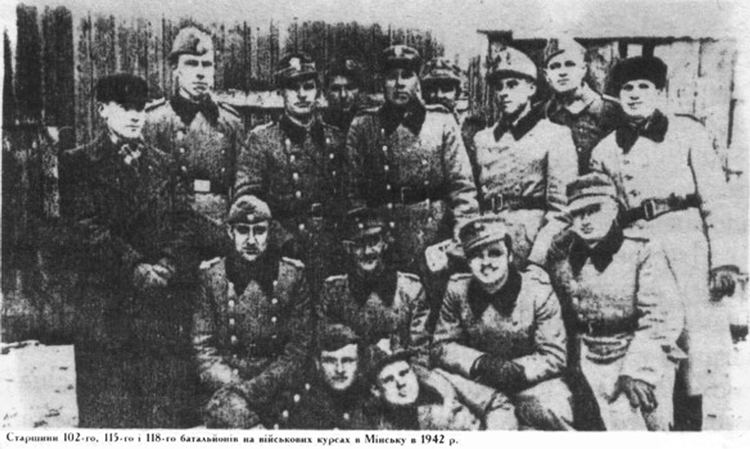 | ||
Active Founded in spring of 1942 Country occupied Poland and the USSR Type Paramilitary volunteer brigade | ||
Schutzmannschaft Battalion 118 of Ukrainische Hilfspolizei was a Schutzmannschaft auxiliary police battalion (Schuma) formed by the Nazis in the spring of 1942 in Kiev in Reichskommissariat Ukraine (now capital of sovereign Ukraine) with 500 volunteers in three companies. The battalion was split away from the Schuma Battalion 115 with 100 members of the third company of the Ukrainian-only Battalion 115 forming the first company of Battalion 118. Additional two new companies were composed of Ukrainian nationalists from Bukovyna and volunteers from the prisoners-of-war camp for the Soviets captured in Ukraine during Operation Barbarossa. The German commander of the battalion was Sturmbannführer Erich Körner.
Contents
The battalion, led by Ukrainian officers (ex Red Army officers) under the leadership of Hryhorii Vasiura (Григорий Васюра, age 27, tried in 1986 by the USSR), was merged back to Battalion 115 in 1944 around East Prussia and transported to France where it formed the 30th Waffen Grenadier Division of the SS.
Operations
In November 1942 the newly-formed Battalion 118 was transferred to Minsk (occupied Belorussian SSR, now capital of sovereign Belarus) and from there for approximately one year to a new base on the outskirts of the former Second Polish Republic. It was active in the area until July 1944. During this time the battalion participated in the German pacification actions, part of the "dead zone" policy of annihilating hundreds of Belarusian villages in order to remove the support base for the alleged partisans. The 60 major and 80 smaller actions affecting 627 villages across occupied Belarus included Operation Hornung, Draufgänger, Cottbus (with 13,000 victims), Hermann (4,280) and Wandsbeck. Entire Jewish communities were exterminated on the general orders of Curt von Gottberg with the necessary backup provided by the Battalions 115 and 102, the Russian ROA, Baltic collaborators, Belarusian Auxiliary Police, and the SS-Sturmbrigade Dirlewanger. They also fought the Polish underground. In 1943, close to 50 men of the 118th battalion deserted and joined the UPA in Volhynia.
In the spring of 1944 due to the Soviet counteroffensive Battalion 118 and Battalion 115 (Ukrainian only) were merged together around East Prussia into a single battalion with up to 600 men. In August 1944, all of them were transported by train to Besançon in France to form the 30th Waffen Grenadier Division of the SS along with other Ukrainian formations. While in the village of Valderharn, some members made contact with the French partisans from FFI and one night the majority deserted to join them. They named themselves the 2nd Ukrainian "Taras Shevchenko" battalion of the French Forces of the Interior (le 2e bataillon ukrainien des Forces françaises de l'intérieur, Groupement Frontière, Sous-région D.2). However, the French after the war wanted to send them back to Russia in accordance with their international agreements, therefore many of the former volunteers continued service in the French Foreign Legion to avoid repatriation.
Atrocities and war crimes
Due to participation in a series of pacification actions, some members of Schutzmannschaft Battalion 118 have been later accused of committing most brutal atrocities and war crimes during World War II. The Khatyn massacre occurred in Khatyn, a village in Belarus, in the Lahojsk district, Minsk Voblast. On March 22, 1943, the population of the village was massacred by Battalion 118.
In an article on the Khatyn massacre, Lund University historian Per Anders Rudling, relying on KGB interrogation reports released in 2008, wrote that the Schutzmannschaft Battalion 118 filled a farmer's barn with civilians, set it on fire, and used a machine gun to kill the civilians who tried to escape the flames: “One witness stated that Volodymyr Katriuk was a particularly active participant in the atrocity: he reportedly lay behind the stationary machine gun, firing rounds on anyone attempting to escape the flames”. A Soviet Union war-crimes trial in 1973 heard that three members of the Schutzmannschaft Battalion 118 killed a group of Belarusian loggers earlier that day, suspecting they were part of a popular uprising. "I saw how Ivankiv was firing with a machine-gun upon the people who were running for cover in the forest, and how Katriuk and Meleshko were shooting the people lying on the road," the witness said. The Schutzmannschaft Battalion 118 was chiefly responsible for the creation of German "dead zones". The dead zone policy involved exterminating communities suspected, or capable of aiding the Soviet partisans who had launched ambushes against Nazi forces in Belarus.
Personnel
The battalion consisted of 3 companies totaling 500 men, divided in 3 companies, which in turn were divided into 3 platoons each:
Names of individuals on record include: I. Kozynchenko, G. Spivak, S. Sakhnо, O. Knap, T. Topchiy, I. Petrichuk, Lakustа (Лакуста), Lukovich (Лукович), Scherban, Varlamov, Khrenov, Yegorov, Subbotin, Iskanderov, Khachaturyan, and Vladimir Katriuk (Катрюк), implicated by witness along with Ivankiv, and Meleshko (Мелешко). Tried in the Soviet Union and sentenced to minor prison terms (for political reasons, as good citizens) were Fedorenko (Федоренко), Golchenko (Гольченко), Vertelnikov (Вертельников), Gontarev (Гонтарев), Funk (Функ), Medvedev (Медведев), Yakovlev (Яковлев), Lappo (Лаппо), Osmakov (Осьмаков), Sulzhenko (Сульженко), Trofimov (Трофимов), Sparrow (Воробья), Kolbasin (Колбасин), and Muravev (Муравьёв).
